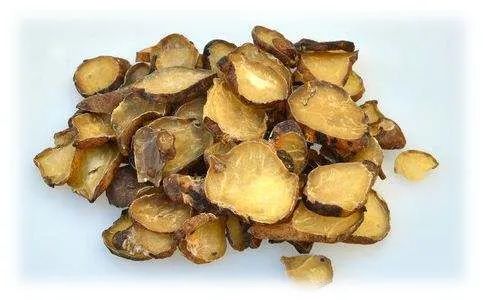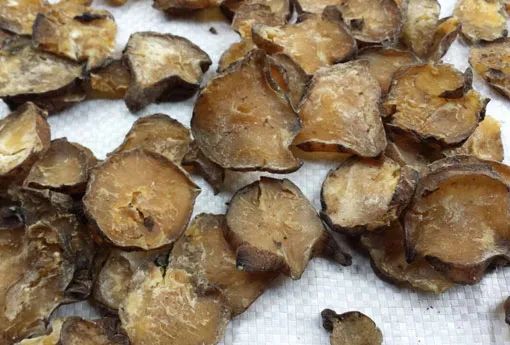The Chinese Pharmacopoeia on Aconite:Taste and Properties: Pungent, Sweet, Very Hot; Toxic.Meridians: Heart, Kidney, Spleen.Main Functions and Indications: Revives Yang and rescues from collapse, supplements fire and assists Yang, expels wind, cold, and dampness. Used for Yang deficiency with cold limbs and weak pulse, impotence, cold uterus, cold pain in the heart and abdomen, deficiency cold with vomiting and diarrhea, Yin cold with edema, Yang deficiency with external pathogens, and cold dampness causing pain.

Due to Aconite’s ability to revive Yang and rescue from collapse, it is often used to treat critical conditions and tackle difficult diseases. This is typically done by experienced TCM practitioners, and adverse reactions or poisoning events are generally rare. On the contrary, because Aconite has the effects of dispelling wind, eliminating dampness, and alleviating pain, it is widely recognized by the public for treating rheumatic bone pain. This characteristic has led to a common habit of self-cooking Aconite. However, Aconite is a toxic herb. Improper preparation or consumption can easily lead to poisoning, endangering life and potentially resulting in death. If a group cooks Aconite together, it can lead to mass poisoning incidents, posing serious health risks and safety concerns for the public, and causing negative social impacts. Therefore, Aconite must be treated with respect and should not be consumed casually.  Important Reminders1. Aconite is a toxic medicinal herb, not a common food, and should not be consumed lightly.2. Inviting others to cook Aconite can lead to poisoning and endanger lives, and one must bear legal responsibility. Therefore, do not casually invite others to cook Aconite.3. Cooking Aconite is best done under the guidance of an experienced TCM practitioner. If you lack experience, do not attempt to cook it on your own. Safety Guidelines for Cooking AconiteFirst, ensure the quality of Aconite, preferably purchasing it from a reputable medical institution.Second, always use boiling water for decoction, with a cooking time of over 4 hours, ensuring the water remains continuously boiling without cooling down, and do not add cold water during the process.Third, keep the medicinal ingredients as simple as possible, avoiding mixing with wild mushrooms or other ingredients that may cause poisoning.Fourth, during the consumption of Aconite, do not drink alcohol, eat raw or cold foods, or expose oneself to rain; maintain warmth and avoid cold; refrain from intense exercise and ensure adequate rest.Fifth, if any discomfort or poisoning symptoms occur, promptly inform family or friends and seek medical attention. Mechanism of Aconite PoisoningThe toxic component of Aconite is primarily aconitine; as little as 2-4 mg can lead to poisoning and death in an adult. However, aconitine is heat-sensitive and undergoes hydrolysis when heated. During high-temperature cooking, aconitine converts to mesaconitine and then to benzoylaconitine. At this stage, the toxicity is only one two-thousandth of that of aconitine. Continued heating can further reduce toxicity to amine alcohols, making Aconite safe to consume.Thus, only Aconite that has been thoroughly cooked at high temperatures is safe.The most common cause of Aconite poisoning is improper decoction, either due to insufficient cooking time or not reaching boiling point, which fails to promote the hydrolysis of aconitine. Symptoms of Aconite PoisoningAconite poisoning symptoms can manifest within minutes or may take two to three hours to appear.Initial symptoms include numbness of the lips and tongue, numbness of the hands and feet, muscle spasms and convulsions in the hands and feet, chest tightness, palpitations, dizziness, blurred vision, burning sensations in the throat, esophagus, and stomach, and salivation.Subsequent symptoms may include nausea, vomiting, diarrhea, agitation, slow pulse, mental dullness, difficulty breathing, low blood pressure, speech difficulties, and incontinence.Severe cases can lead to coma, convulsions, respiratory arrest, and death due to circulatory or respiratory failure.The primary cause of death from Aconite poisoning is arrhythmia. Aconitine directly affects myocardial cells, enhancing myocardial excitability, leading to arrhythmias, and severe cases can result in respiratory and cardiac arrest, causing death. First Aid Measures for Aconite Poisoning1. Immediately induce vomiting to reduce toxin accumulation. You can use a feather, cotton swab, or finger to stimulate the throat to induce vomiting.2. Here are some simple detoxification methods: frequent consumption of decoctions made from ginger, licorice, mung beans; coriander decoction; or brown sugar and ginger decoction. If you lack experience in treatment, do not attempt these simple detox methods; seeking immediate medical attention is the priority to avoid delaying rescue.3. If any poisoning symptoms occur, regardless of severity, seek treatment under the guidance of medical professionals, and it is advisable to call for emergency help.
Important Reminders1. Aconite is a toxic medicinal herb, not a common food, and should not be consumed lightly.2. Inviting others to cook Aconite can lead to poisoning and endanger lives, and one must bear legal responsibility. Therefore, do not casually invite others to cook Aconite.3. Cooking Aconite is best done under the guidance of an experienced TCM practitioner. If you lack experience, do not attempt to cook it on your own. Safety Guidelines for Cooking AconiteFirst, ensure the quality of Aconite, preferably purchasing it from a reputable medical institution.Second, always use boiling water for decoction, with a cooking time of over 4 hours, ensuring the water remains continuously boiling without cooling down, and do not add cold water during the process.Third, keep the medicinal ingredients as simple as possible, avoiding mixing with wild mushrooms or other ingredients that may cause poisoning.Fourth, during the consumption of Aconite, do not drink alcohol, eat raw or cold foods, or expose oneself to rain; maintain warmth and avoid cold; refrain from intense exercise and ensure adequate rest.Fifth, if any discomfort or poisoning symptoms occur, promptly inform family or friends and seek medical attention. Mechanism of Aconite PoisoningThe toxic component of Aconite is primarily aconitine; as little as 2-4 mg can lead to poisoning and death in an adult. However, aconitine is heat-sensitive and undergoes hydrolysis when heated. During high-temperature cooking, aconitine converts to mesaconitine and then to benzoylaconitine. At this stage, the toxicity is only one two-thousandth of that of aconitine. Continued heating can further reduce toxicity to amine alcohols, making Aconite safe to consume.Thus, only Aconite that has been thoroughly cooked at high temperatures is safe.The most common cause of Aconite poisoning is improper decoction, either due to insufficient cooking time or not reaching boiling point, which fails to promote the hydrolysis of aconitine. Symptoms of Aconite PoisoningAconite poisoning symptoms can manifest within minutes or may take two to three hours to appear.Initial symptoms include numbness of the lips and tongue, numbness of the hands and feet, muscle spasms and convulsions in the hands and feet, chest tightness, palpitations, dizziness, blurred vision, burning sensations in the throat, esophagus, and stomach, and salivation.Subsequent symptoms may include nausea, vomiting, diarrhea, agitation, slow pulse, mental dullness, difficulty breathing, low blood pressure, speech difficulties, and incontinence.Severe cases can lead to coma, convulsions, respiratory arrest, and death due to circulatory or respiratory failure.The primary cause of death from Aconite poisoning is arrhythmia. Aconitine directly affects myocardial cells, enhancing myocardial excitability, leading to arrhythmias, and severe cases can result in respiratory and cardiac arrest, causing death. First Aid Measures for Aconite Poisoning1. Immediately induce vomiting to reduce toxin accumulation. You can use a feather, cotton swab, or finger to stimulate the throat to induce vomiting.2. Here are some simple detoxification methods: frequent consumption of decoctions made from ginger, licorice, mung beans; coriander decoction; or brown sugar and ginger decoction. If you lack experience in treatment, do not attempt these simple detox methods; seeking immediate medical attention is the priority to avoid delaying rescue.3. If any poisoning symptoms occur, regardless of severity, seek treatment under the guidance of medical professionals, and it is advisable to call for emergency help.
For more content, please long-press the QR code below to follow!


